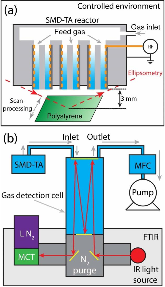Interaction of Long-lived Reactive Species from Cold Atmospheric Pressure Plasma with Polymers: Chemical Modification by Ozone and Reactive Oxygen-Nitrogen Species
Abstract
Atmospheric pressure plasma (APP) sources are able to generate a variety of reactive species that have different effects on materials, such as functionalization, etching and deposition. In this article, we study the effect of long-lived reactive neutral species on polymers using a model plasma-surface interaction (PSI) system that consists of ultra-thin (~10 nm) polystyrene (PS) films and a surface micro-discharge (SMD) reactor operated with various N2/O2 working gas mixtures. We characterized and quantified the reactive species generated by SMD using IR and UV absorption, and we found that O3, N2O5, N2O and HNO3 are the dominant long-lived reactants near the target surface. When exposing PS films to these reactive species, we observed material responses including film thickness expansion, surface and bulk oxidation, and surface organic nitrate formation. The quantity of these changes varied with the N2/O2 working gas composition. By correlating material response with gas phase species, we find that the chemical modification of PS strongly depends on the density of O3 in the gas phase, which is indicative of an essential role of O3 in the remote APP treatment of polymers. Our results show that O3 causes polymer surface oxidation, participates in the diffusion-reaction process in the polymer bulk,more »
- Authors:
-
- Univ. of Maryland, College Park, MD (United States)
- Publication Date:
- Research Org.:
- Univ. of Maryland, College Park, MD (United States)
- Sponsoring Org.:
- USDOE Office of Science (SC), Fusion Energy Sciences (FES)
- OSTI Identifier:
- 1544429
- Alternate Identifier(s):
- OSTI ID: 1556810
- Grant/Contract Number:
- SC0001939
- Resource Type:
- Journal Article: Accepted Manuscript
- Journal Name:
- Journal of Vacuum Science and Technology A
- Additional Journal Information:
- Journal Volume: 37; Journal Issue: 5; Journal ID: ISSN 0734-2101
- Publisher:
- American Vacuum Society / AIP
- Country of Publication:
- United States
- Language:
- English
- Subject:
- 36 MATERIALS SCIENCE; Atmospheric pressure plasma; cold temperature plasma; polystyrene; surface modification; Plasma Science and Technology: plasma processing; Plasma Science and Technology: plasma etching processes; Plasma Science and Technology: surface reactions and plasma-surface interactions; Surface Science & Applied Surface Science: surface oxidation; Surface Science & Applied Surface Science: polymer surfaces
Citation Formats
Luan, Pingshan, and Oehrlein, Gottlieb S. Interaction of Long-lived Reactive Species from Cold Atmospheric Pressure Plasma with Polymers: Chemical Modification by Ozone and Reactive Oxygen-Nitrogen Species. United States: N. p., 2019.
Web. doi:10.1116/1.5109651.
Luan, Pingshan, & Oehrlein, Gottlieb S. Interaction of Long-lived Reactive Species from Cold Atmospheric Pressure Plasma with Polymers: Chemical Modification by Ozone and Reactive Oxygen-Nitrogen Species. United States. https://doi.org/10.1116/1.5109651
Luan, Pingshan, and Oehrlein, Gottlieb S. 2019.
"Interaction of Long-lived Reactive Species from Cold Atmospheric Pressure Plasma with Polymers: Chemical Modification by Ozone and Reactive Oxygen-Nitrogen Species". United States. https://doi.org/10.1116/1.5109651. https://www.osti.gov/servlets/purl/1544429.
@article{osti_1544429,
title = {Interaction of Long-lived Reactive Species from Cold Atmospheric Pressure Plasma with Polymers: Chemical Modification by Ozone and Reactive Oxygen-Nitrogen Species},
author = {Luan, Pingshan and Oehrlein, Gottlieb S.},
abstractNote = {Atmospheric pressure plasma (APP) sources are able to generate a variety of reactive species that have different effects on materials, such as functionalization, etching and deposition. In this article, we study the effect of long-lived reactive neutral species on polymers using a model plasma-surface interaction (PSI) system that consists of ultra-thin (~10 nm) polystyrene (PS) films and a surface micro-discharge (SMD) reactor operated with various N2/O2 working gas mixtures. We characterized and quantified the reactive species generated by SMD using IR and UV absorption, and we found that O3, N2O5, N2O and HNO3 are the dominant long-lived reactants near the target surface. When exposing PS films to these reactive species, we observed material responses including film thickness expansion, surface and bulk oxidation, and surface organic nitrate formation. The quantity of these changes varied with the N2/O2 working gas composition. By correlating material response with gas phase species, we find that the chemical modification of PS strongly depends on the density of O3 in the gas phase, which is indicative of an essential role of O3 in the remote APP treatment of polymers. Our results show that O3 causes polymer surface oxidation, participates in the diffusion-reaction process in the polymer bulk, and results in aromatic ring cleavage and the formation of carbonyl groups. In contrast, we did not find a correlation between surface organic nitrate and individual long-lived reactive species mentioned above. This indicates that surface organic nitrate formation on polymer surfaces might result from the interaction of multiple reactive species, including O3 and nitrogen containing species. A model for the interphase mass transfer of reactive species from gas to solid was also described.},
doi = {10.1116/1.5109651},
url = {https://www.osti.gov/biblio/1544429},
journal = {Journal of Vacuum Science and Technology A},
issn = {0734-2101},
number = 5,
volume = 37,
place = {United States},
year = {Tue Jul 23 00:00:00 EDT 2019},
month = {Tue Jul 23 00:00:00 EDT 2019}
}
Web of Science
Figures / Tables:
 FIG. 1: (a) Schematic diagram of polymer scan-processing by the SMD-TA. The target PS film is placed underneath the nozzle at a distance of 3 mm. (b) Schematic diagram of the gas phase species characterization by FTIR with a variable-length gas detection cell. A liquid N2 cooled MCT detector ismore »
FIG. 1: (a) Schematic diagram of polymer scan-processing by the SMD-TA. The target PS film is placed underneath the nozzle at a distance of 3 mm. (b) Schematic diagram of the gas phase species characterization by FTIR with a variable-length gas detection cell. A liquid N2 cooled MCT detector ismore »
Works referencing / citing this record:
The effect of mixed electric field on characteristic of Ar–N 2 plasma jets for TiN surface treatment
journal, January 2020
- Seyfi, P.; Khademi, A.; Ghasemi, S.
- Journal of Physics D: Applied Physics, Vol. 53, Issue 12
Figures / Tables found in this record: